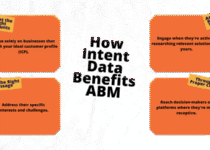Account-Based Advertising Strategies: Drive 81% Higher ROI With Targeted Campaigns
For high-value B2B marketing, it’s no longer enough to cast a wide net and hope to catch the right fish. Companies that align Account-Based Marketing with Account-Based Advertising report 60% higher win rates than those that don’t, according to RollWorks. This significant performance gap underscores a fundamental shift in how successful B2B organizations approach their advertising efforts.
Account-based advertising (ABA) represents a strategic evolution in marketing that allocates resources towards specific high-value accounts rather than broad demographic segments. Instead of hoping the right decision-makers find you, ABA enables you to deliver hyper-targeted messaging directly to the buying committees at your ideal customer accounts.
In this comprehensive guide, we’ll explore the proven account-based advertising strategies that leading B2B marketers are implementing to drive engagement, accelerate pipeline velocity, and boost conversion rates. From targeting techniques and creative execution to measurement frameworks and real-world case studies, we’ll provide actionable insights to transform your advertising approach.
Key Takeaways
- Account-based advertising dramatically outperforms traditional approaches with companies reporting 60% higher win rates, 81% higher ROI, and 14% increased pipeline conversion rates when implementing targeted ABA strategies.
- Multi-channel orchestration is essential for effective account-based advertising strategies, delivering 97% higher ROI than single-channel efforts by creating consistent messaging across display ads, LinkedIn, retargeting, direct mail, and email.
- Data-driven personalization transforms campaign performance with 60% of successful account-based programs now leveraging AI-driven personalization to deliver tailored messaging at the account level, role level, and based on behavioral signals.
- Sales and marketing alignment is critical for identifying target accounts, developing relevant messaging, coordinating follow-up, and measuring the true impact of account-based advertising on revenue outcomes.
- Privacy-compliant targeting approaches are becoming increasingly important as third-party cookies phase out, with successful ABA strategies now leveraging first-party data activation, partner-based targeting, contextual advertising, and IP-based targeting.
TABLE OF CONTENTS:
Understanding Account-Based Advertising in the ABM Ecosystem
The Strategic Account-Based Advertising Foundation
Account-based advertising represents the paid media component of a broader account-based marketing (ABM) strategy. While traditional advertising casts a wide net to generate leads that might eventually convert, ABA flips this model by first identifying high-value target accounts, then deploying personalized advertising specifically designed to engage key stakeholders within those organizations.
This approach aligns perfectly with the reality of B2B purchasing: decisions rarely come down to a single person. Instead, buying committees with 6-10 stakeholders from different departments collectively evaluate solutions. Account-based advertising strategies enable marketers to address the collective needs of these committees while tailoring messaging to each role’s specific concerns.
Why Traditional Advertising Falls Short for Complex B2B Sales
Traditional lead-based advertising suffers from several limitations when applied to complex B2B sales cycles:
- Inefficient resource allocation: Budget gets wasted on prospects that don’t match your ideal customer profile
- Fragmented buying journey: Different stakeholders encounter inconsistent messaging across channels
- Measurement challenges: Traditional metrics like clicks and form fills don’t reflect actual pipeline impact
- Disconnection from sales: Advertising operates in isolation from sales intelligence and account strategies
According to data from Demandbase, top B2B marketers using account-based marketing strategies, which include tailored advertising approaches and data-driven personalization, achieve an 81% higher ROI than their peers. This dramatic difference stems from ABA’s ability to focus resources on the accounts most likely to convert, with messaging specifically designed to address their needs.
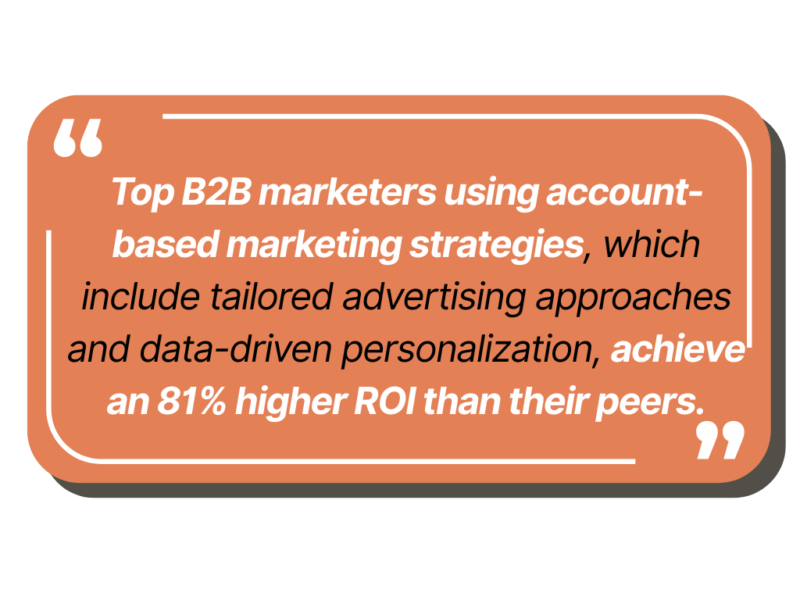
Core Components of Effective Account-Based Advertising Strategies
The most successful account-based advertising strategies share several critical components that work together to create a cohesive, high-performing program. Let’s examine each element in detail.
Target Account Selection and Tiering
The foundation of any account-based advertising strategy is identifying which accounts deserve your focus. This process typically involves:
- Ideal Customer Profile (ICP) Development: Analyzing your best existing customers to identify common attributes, including industry, company size, technology stack, and business challenges.
- Intent Signal Analysis: Leveraging third-party data to identify accounts actively researching solutions in your category.
- Firmographic and Technographic Filtering: Using business attributes and technology usage data to refine your target list.
- Account Tiering: Categorizing target accounts based on potential value and likelihood to convert, with advertising investment allocated accordingly.
Many organizations leverage account-based targeting tools on LinkedIn and other platforms to streamline this process and ensure proper audience segmentation.
Multi-Channel Orchestration
Utilizing a multi-channel approach in ABM strategies leads to a remarkable 97% higher ROI than single-channel efforts, according to TechFunnel research. Effective account-based advertising strategies coordinate messaging across multiple channels:
| Channel | Strategic Role | Targeting Capabilities |
|---|---|---|
| Display Advertising | Broad reach within target accounts | IP-based, cookie-based, and domain targeting |
| LinkedIn Advertising | Precise role-based targeting | Job title, seniority, skills, and account lists |
| Retargeting | Engagement reinforcement | Site visitors from target accounts |
| Direct Mail | High-impact outreach to key decision-makers | Physical location targeting |
| Personalized nurturing | Known contacts within target accounts |
The key to success lies not just in using multiple channels, but in orchestrating them to deliver consistent messaging with appropriate timing. This coordinated approach creates multiple touchpoints throughout the buyer’s journey, increasing the likelihood of engagement across the buying committee.
Personalization at Scale
In 2024, 60% of account-based programs use AI-driven personalization to optimize content, according to Converge360. This trend reflects the critical importance of tailored messaging in account-based advertising strategies.
Effective personalization in ABA operates at multiple levels:
- Account-level personalization: Customizing creative elements to reflect the target company’s industry, challenges, and opportunities
- Role-based personalization: Tailoring value propositions to address the specific concerns of different stakeholders
- Behavioral personalization: Adjusting messaging based on previous engagement and intent signals
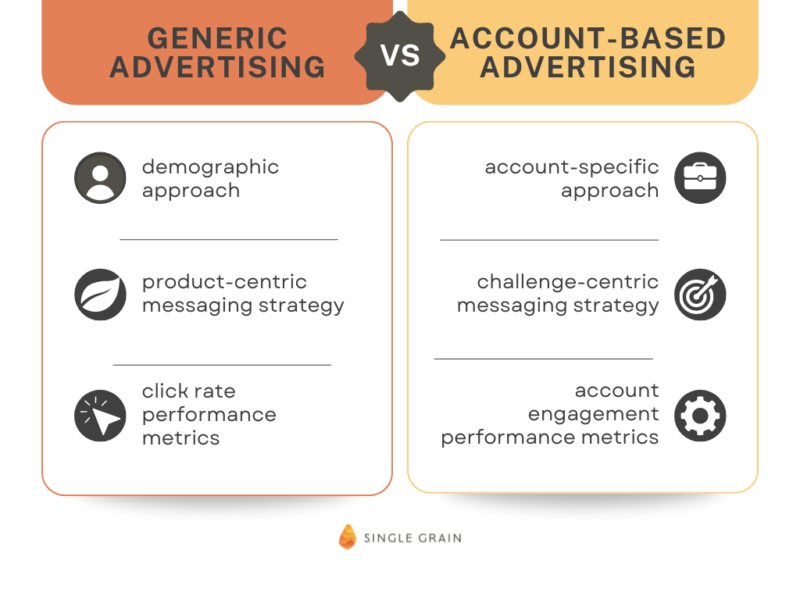
Sales and Marketing Alignment
Account-based advertising strategies require close collaboration between marketing and sales teams. This alignment is critical for:
- Identifying target accounts: Joint selection of accounts based on both marketing data and sales intelligence
- Developing relevant messaging: Creating advertising content that addresses the specific pain points sales teams are hearing from prospects
- Coordinating follow-up: Ensuring sales teams are prepared to engage when advertising generates interest
- Measuring impact: Tracking how advertising influences deal progression and closed revenue
According to Gartner, companies implementing effective account-based marketing strategies experience a 14% increase in pipeline conversion rates, demonstrating that structured approaches can lead to more efficient sales processes.
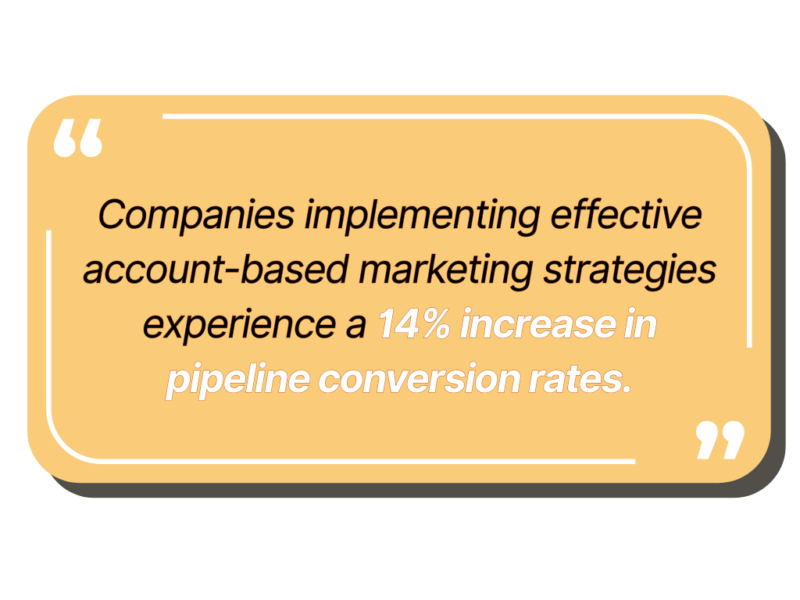
Data-Driven Implementation Techniques for Account-Based Advertising
The most effective account-based advertising strategies are powered by sophisticated data and technology approaches that enable precise targeting, personalization, and measurement. Here’s how leading organizations are implementing these techniques.
Leveraging Intent Data and Behavioral Signals
Intent data—information that indicates an account is actively researching solutions in your category—has become a cornerstone of advanced account-based advertising strategies. This data comes from various sources:
- First-party intent data: Website visits, content downloads, email engagement, and event attendance
- Third-party intent data: Research activities across publishing networks, forum discussions, and review sites
- Partner intent data: Information shared by technology partners about mutual prospects’ activities
By identifying which accounts are showing increased interest in relevant topics, marketers can prioritize advertising spend on organizations that are already in an active buying cycle, significantly increasing efficiency and effectiveness.
Case Study: Demandbase
Challenge: B2B marketers were under pressure to break through digital noise and effectively reach decision-makers in key accounts while complying with tighter privacy regulations.
Solution: Adopted data-driven ABA strategies by leveraging AI for real-time insights, integrating both first- and third-party intent data, and automating cross-channel campaign execution across email, display, social, and personalized web experiences.
Results: Achieved a 2.6x average increase in engagement rates on targeted accounts, a 32% higher conversion rate compared to non-account-based programs, and a 21% reduction in wasted ad spend.
Key Takeaway: Integrating AI-driven analytics and intent data into account-based advertising can dramatically boost engagement and conversion while reducing ad spend waste.
AI and Predictive Analytics in Account-Based Advertising
The integration of artificial intelligence and machine learning has transformed account-based advertising strategies in several key ways:
- Predictive account scoring: AI models can analyze historical data to identify which accounts are most likely to convert, helping marketers prioritize their highest-value targets.
- Dynamic creative optimization: Machine learning algorithms can test and optimize ad creative in real-time, determining which messages resonate best with specific accounts and roles.
- Journey stage mapping: AI can analyze engagement patterns to determine where accounts are in their buying process, enabling more relevant messaging.
- Conversion path analysis: Machine learning helps identify the most effective sequences of touchpoints that lead to successful outcomes for different account types.
This technology-driven approach aligns with the finding that account-based marketing personalization is critical for engaging today’s sophisticated B2B buyers who expect relevant, contextual experiences.
Measurement Frameworks and KPIs
Traditional advertising metrics like click-through rates and cost per lead don’t adequately capture the impact of account-based advertising strategies. Successful organizations use more sophisticated measurement frameworks:
Account Engagement Metrics:
- Account reach percentage (what portion of target accounts are being exposed to ads)
- Account engagement rate (what percentage of accounts are taking meaningful actions)
- Multi-stakeholder engagement (how many individuals within each account are engaging)
Pipeline Impact Metrics:
- Influenced pipeline (how advertising contributes to opportunity creation)
- Pipeline velocity (how advertising accelerates deal progression)
- Win rate improvement (how advertising impacts close rates)
Financial Metrics:
- Cost per engaged account
- Customer acquisition cost (CAC) by account tier
- Return on advertising spend (ROAS) for account-based campaigns
Overcoming Common Challenges in Account-Based Advertising
While account-based advertising strategies deliver superior results, they also present unique challenges that organizations must address to maximize effectiveness.
Creative Production and Personalization Bottlenecks
One of the biggest challenges in scaling account-based advertising is producing enough personalized creative assets for different accounts, industries, and roles. To overcome this challenge:
- Create modular creative frameworks that allow for easy customization of key elements without rebuilding entire assets.
- Leverage dynamic creative optimization (DCO) technology to automatically personalize elements based on the viewer’s company, industry, or role.
- Develop tiered personalization approaches where top-tier accounts receive fully customized creative while lower tiers use semi-personalized templates.
- Use AI-powered content generation tools to scale personalization efforts more efficiently.
These approaches allow marketing teams to deliver personalized experiences without overwhelming creative resources.
Alignment Between Inbound and Account-Based Efforts
Many organizations struggle to integrate their traditional inbound marketing with account-based advertising strategies. Best practices for integration include:
- Unified data infrastructure that captures both inbound leads and account-based engagement
- Coordinated messaging frameworks ensuring consistent value propositions across both approaches
- Intelligent routing processes that treat inbound leads from target accounts differently
- Integrated measurement models that evaluate both approaches within a common framework
By viewing inbound and account-based advertising as complementary rather than competing approaches, organizations can create a more cohesive overall marketing strategy.
Attribution and Measurement Complexities
Measuring the impact of account-based advertising presents unique challenges because multiple stakeholders from the same organization may interact with various touchpoints over an extended period. Advanced organizations address this by:
- Implementing account-based attribution models that track engagement across the entire buying committee
- Creating unified views of account activity across marketing and sales touchpoints
- Establishing clear agreements about how influence is tracked and credited
- Focusing on account-level outcomes rather than individual lead metrics
With proper measurement frameworks in place, organizations can accurately assess the ROI of their account-based advertising strategies and optimize accordingly.
Advanced Tactics and Emerging Trends in Account-Based Advertising
The field of account-based advertising continues to evolve rapidly. Forward-thinking marketers are exploring several advanced approaches and emerging trends.
Integrated Multi-Channel Sequencing
The most sophisticated account-based advertising strategies incorporate carefully orchestrated sequences across multiple channels to create a cohesive buying experience.
Case Study: SundaySky
- Challenge: Faced low engagement and conversion rates from generic digital advertising when targeting high-value accounts.
- Solution: Implemented a multi-channel ABM strategy by deploying a coordinated sequence of personalized emails, LinkedIn ads, and direct mail, using intent data for precise timing and messaging personalization.
- Results: Achieved a 220% increase in conversion rates among target accounts, accelerated sales cycles, and increased deal sizes through an effective measurement framework focused on account-level outcomes.
- Key Takeaway: A coordinated multichannel approach with precise sequencing and measurement can significantly enhance conversion and drive faster pipeline progression.
This integrated approach requires sophisticated orchestration capabilities but delivers substantially better results than disconnected channel efforts.
Conversational Marketing Integration
Increasingly, account-based advertising strategies are being integrated with conversational marketing platforms like chatbots and live chat to create more immediate engagement opportunities when target accounts visit your website. This approach:
- Personalizes the website experience based on the visitor’s company and previous advertising exposure
- Creates opportunities for real-time conversation with engaged accounts
- Accelerates pipeline by connecting interested stakeholders directly with sales teams
- Provides valuable feedback on which advertising messages are driving engagement
By connecting advertising directly to conversation, organizations can significantly reduce the time from awareness to meaningful engagement.
Privacy-First Targeting Approaches
As third-party cookies phase out and privacy regulations tighten, account-based advertising strategies are evolving to leverage privacy-compliant identification methods:
- First-party data activation: Using your own customer and prospect data to build custom audiences
- Partner-based targeting: Working with media partners who have direct relationships with users
- Contextual targeting: Placing ads in relevant content environments likely to attract your target accounts
- IP-based targeting: Identifying and targeting corporate networks of target accounts
These approaches ensure account-based advertising can remain effective even as traditional targeting methods face increasing limitations.
Implementing Your Account-Based Advertising Strategy: A Roadmap
Based on the proven strategies we’ve explored, here’s a practical roadmap for implementing or enhancing your account-based advertising approach.
Step 1: Foundation Building
Start by establishing the essential components needed for successful execution:
- Target account list: Develop your ICP and identify 50-500 accounts that align with your criteria.
- Stakeholder mapping: Identify the key roles involved in purchasing decisions at your target accounts.
- Value proposition alignment: Ensure your messaging addresses the specific needs of different stakeholders.
- Channel selection: Determine which advertising channels will be most effective for reaching your target accounts.
- Measurement framework: Establish how you’ll track success, focusing on account-level metrics.
Step 2: Pilot Program Execution
Before scaling, implement a focused pilot program:
- Select a smaller subset of target accounts (10-50) for your initial efforts.
- Develop personalized creative for these accounts.
- Deploy advertising across your chosen channels.
- Establish tight coordination with sales for follow-up.
- Track results meticulously to establish baseline performance.
Step 3: Optimization and Scaling
Based on pilot results, refine your approach and expand your program:
- Analyze which creative approaches drove the strongest engagement
- Identify which channels delivered the best results for different account types
- Refine your targeting criteria based on which accounts showed the most interest
- Scale successful tactics while eliminating underperforming elements
- Implement more advanced personalization and measurement capabilities
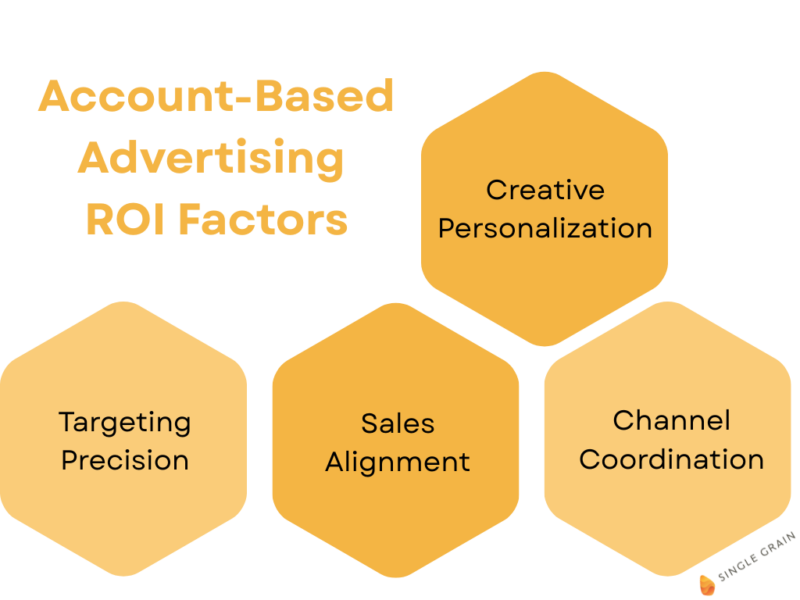
Step 4: Advanced Integration
Once your core account-based advertising program is performing well, integrate more sophisticated elements:
- AI-powered optimization: Implement machine learning to continuously improve targeting and creative.
- Expanded channel mix: Add additional channels like connected TV, audio, or direct mail for high-value accounts.
- Dynamic journey orchestration: Create responsive advertising experiences that adapt based on account engagement.
- Predictive analytics: Use AI to identify which accounts are most likely to convert and prioritize accordingly.
You can personalize & scale your LinkedIn ABM ads with specialized tools designed for account-based targeting and personalization at scale.
The Future of Account-Based Advertising
Account-based advertising strategies represent the evolution of B2B marketing from broad-based campaigns to highly targeted, personalized engagement with high-value accounts. As we’ve explored, this approach delivers significantly better results across key metrics:
- Higher win rates (60% improvement when ABM and ABA are aligned)
- Superior ROI (81% higher for top B2B marketers using account-based strategies)
- Increased pipeline conversion (14% boost with effective implementation)
- Stronger multi-channel impact (97% higher ROI with coordinated approaches)
The most successful organizations are those that view account-based advertising as an integrated component of a comprehensive account-based marketing strategy. By aligning advertising efforts with sales activities, content marketing, and direct outreach, these companies create coherent buying experiences that resonate with target accounts.
As privacy regulations evolve and technical capabilities advance, account-based advertising will continue to transform. Organizations that build strong foundations now—focusing on accurate targeting, compelling personalization, cross-channel coordination, and meaningful measurement—will be best positioned to adapt to these changes and maintain their competitive advantage.
The question is no longer whether to implement account-based advertising strategies, but how quickly you can evolve your approach to keep pace with leading performers in your industry.
Related Video
The post Account-Based Advertising Strategies: Drive 81% Higher ROI With Targeted Campaigns appeared first on Single Grain.


